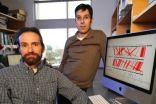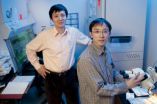First stars in universe were not alone
Astrophysicists use computer simulations to gain new insights on star formation
2011-02-05
(Press-News.org) The first stars in the universe were not as solitary as previously thought. In fact, they could have formed alongside numerous companions when the gas disks that surrounded them broke up during formation, giving birth to sibling stars in the fragments. These are the findings of studies performed with the aid of computer simulations by researchers at Heidelberg University's Centre for Astronomy together with colleagues at the Max Planck Institute for Astrophysics in Garching and the University of Texas at Austin (USA). The group's findings, published in Science Express, cast an entirely new light on the formation of the first stars after the Big Bang.
Stars evolve from cosmic gas clouds in a fierce and complex battle between gravity and internal gas pressure. The density of the gas increases due to its own gravitational pull. This causes the gas to heat up, as a consequence the pressure rises, and the compression process comes to a halt. If the gas manages to get rid of the thermal energy, compression can continue and a new star is born. This cooling process works especially well if the gas contains chemical elements like carbon or oxygen. Stars forming in this way are normally low in mass, like our Sun. But in the early universe these elements had yet to emerge, so the primordial cosmic gas could not cool down very well. Accordingly, most theoretical models predict the masses of primordial stars to be about a hundred times greater than that of the Sun.
Heidelberg astrophysicist Dr. Paul Clark and his colleagues investigated these processes with the help of very high resolution computer simulations. Their findings indicate that this simple picture needs to be revised and that the early universe was not only populated by huge, solitary stars. The reason is the underlying physics of the so called accretion disks accompanying the birth of the very first stars. The gas from which a new star forms rotates, and so the gas is unable to fall directly onto the star, but first builds up a disk-like structure. Only as a result of internal friction can the gas continue to flow onto the star. If more mass falls onto this disk than it can transport inwards, it becomes unstable and breaks into several fragments. So instead of forming just one star at the centre, a group of several stars is formed. The distances between some of the stars can be as small as that between the Earth and the Sun.
According to Dr. Clark, this realisation opens up exciting new avenues for detecting the first stars in the universe. In the final stages of their lives, binaries or multiple stellar systems can produce intense bursts of X-rays or gamma rays. Future space missions are being planned specifically to investigate such bursts from the early universe. It is also conceivable that some of the first stars may have been catapulted out of their birth group through collisions with their neighbours before they were able to accumulate a great deal of mass. Unlike short-lived high-mass stars, low-mass stars may survive for billions of years. "Intriguingly," says Dr. Clark, "some low-mass primordial stars may even have survived to the present day, allowing us to probe the earliest stages of star and galaxy formation right in our own cosmic backyard."
Together with Dr. Simon Glover and Dr. Rowan Smith, Dr. Paul Clark is a member of the star-formation research group headed by Prof. Dr. Ralf Klessen at Heidelberg University's Centre for Astronomy. Also involved in the research were Dr. Thomas Greif of the Max Planck Institute for Astrophysics (Garching) and Prof. Dr. Volker Bromm of the University of Texas. This research was funded by the Baden-Württemberg Foundation as part of the International Top-Level Research II programme. Additional support came from the FRONTIER innovation fund of Heidelberg University as well as the German Research Foundation, the US National Science Foundation, and NASA.
INFORMATION:
For more information, go to www.ita.uni-heidelberg.de/research/klessen/science/starformation.shtml.
Note for news desks:
Digital photo material is available from the Press Office.
Original publication:
P.C. Clark, S.C.O. Glover, R.J. Smith, T.H. Greif, R.S. Klessen, V. Bromm: The Formation and Fragmentation of Disks around Primordial Protostars. Science Express, 3 February 2011, doi: 10.1126/science.1198027
Contact:
Prof. Dr. Ralf Klessen
Centre for Astronomy
Institute of Theoretical Astrophysics
phone: +49 6221 548978
rklessen@ita.uni-heidelberg.de
END
ELSE PRESS RELEASES FROM THIS DATE:
2011-02-05
Things are not always what they seem when it comes to fish—something scientists at the Smithsonian Institution and the Ocean Science Foundation are finding out. Using modern genetic analysis, combined with traditional examination of morphology, the scientists discovered that what were once thought to be three species of blenny in the genus Starksia are actually 10 distinct species. The team's findings are published in the scientific journal ZooKeys, Feb. 3.
Starksia blennies, small (less than 2 inches) fish with elongated bodies, generally native to shallow to moderately ...
2011-02-05
The vaccine for human papillomavirus (HPV) can prevent 90 percent of genital warts in men when offered before exposure to the four HPV strains covered by the vaccine, according to a new multi-center study led by H. Lee Moffitt Cancer Center and UCSF.
The four-year, international clinical trial, which also found a nearly 66 percent effectiveness in the general population of young men regardless of prior exposure to these strains, provides the first reported results of using the HPV vaccine as a prophylactic in men.
Initial data from this study informed the Food and Drug ...
2011-02-05
NEW YORK (February 4, 2011) – Researchers at the NYU Child Study Center demonstrated that a brief program for families of Pre-Kindergarten students attending schools in disadvantaged urban communities improved children's behavior at school. The study, called "Promoting effective parenting practices and preventing child behavior problems in school among ethnically diverse families from underserved, urban communities," was published in the February 2011 issue of Child Development.
Dr. Laurie Miller Brotman and her colleagues spent several years developing ParentCorps, ...
2011-02-05
Since the days of Darwin, the "tree of life" has been the preeminent metaphor for the process of evolution, reflecting the gradual branching and changing of individual species.
The discovery that a large cluster of genes appears to have jumped directly from one species of fungus to another, however, significantly strengthens the argument that a different metaphor, such as a mosaic, may be more appropriate.
"The fungi are telling us something important about evolution … something we didn't know," said Antonis Rokas, assistant professor of biological sciences at Vanderbilt. ...
2011-02-05
An ambitious hunt by Johns Hopkins scientists for actively "jumping genes" in humans has yielded compelling new evidence that the genome, anything but static, contains numerous pesky mobile elements that may help to explain why people have such a variety of physical traits and disease risks.
Using bioinformatics to compare the standard assembly of genetic elements as outlined in the reference human genome to raw whole-genome data from 310 individuals recently made available by the 1000 Genomes Project, the team revealed 1,016 new insertions of RIPs, or retrotransposon ...
2011-02-05
Researchers at Case Western Reserve University have developed a little bomb that promises a big bang for cancer patients.
Preliminary tests show an anti-cancer drug loosely attached to gold nanoparticles starts accumulating deep inside tumors within minutes of injection and can be activated for an effective treatment within two hours. The same drug injected alone takes two days to gather and attacks the tumor from the surface – a far less effective route.
The work, titled "Deep Penetration of a PDT Drug into Tumors by Noncovalent Drug-Gold Nanoparticle Conjugates," ...
2011-02-05
Mice know fear. And they know to fear the scent of a predator. But how do their brains quickly figure out with a sniff that a cat is nearby?
It's a complex process that starts with the scent being picked up by specific receptors in their noses. But until now it wasn't clear exactly how these scent signals proceeded from nose to noggin for neural processing.
In a study to be published in Nature (available online now to subscribers), Stanford researchers describe a new technique that makes it possible to map long-distance nerve connections in the brain. The scientists ...
2011-02-05
CHICAGO --- Small calf muscles may be a feminine trait, but for women with peripheral artery disease (PAD) they're a major disadvantage. Researchers at Northwestern Medicine point to the smaller calf muscles of women as a gender difference that may cause women with PAD to experience problems walking and climbing stairs sooner and faster than men with the disease.
The study was published in the February 2011 issue of the Journal of the American College of Cardiology.
Peripheral artery disease affects eight million men and women in the United States. The disease causes ...
2011-02-05
MyBinding,com, a division of Information Management Services, LCC, announces the promotion of Shawn Slotkin from Account Executive to Inside Sales Supervisor
MyBinding.com, one of the country's leading online retailers of document finishing equipment and supplies, recently announced that one of their account executives, Shawn Slotkin, has been promoted. Slotkin is now serving as Inside Sales Supervisor. His promotion was announced in a company e-mail on Friday, January 28, 2011.
"I'm excited," said Slotkin. "I've been waiting for this opportunity for quite a while." ...
2011-02-05
Because many women business owners are solopreneurs, they often learn the ins and outs of business ownership on their own. They may not recognize what is possible for themselves or for their businesses because they haven't had the experience or exposure. The good news is that it is possible for these female entrepreneurs to become successful with ease - by receiving support from experts and from people in the community.
Bringing In the Experts: Saving Time and Money, and Reaching Goals Faster is the latest article by professional marketing researcher and entrepreneurial ...
LAST 30 PRESS RELEASES:
[Press-News.org] First stars in universe were not alone
Astrophysicists use computer simulations to gain new insights on star formation


